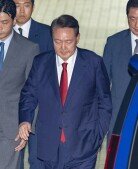Income differences between classes to widen
Income differences between classes to widen
Posted September. 07, 2000 21:14,
It appears that the income gaps between the classes are gradually growing. Moreover, the living standards of workers seem unchanged although the economy has recovered to pre-IMF crisis levels.
According to the national statistical administration¡¯s report on September 7 on the average city workers¡¯ household balance for the second quarter of this year, the monthly income per household recorded 2,331,000 Won, an increase of 10.9% from the same period last year, while household expenditures totalled 1,542,000 Won, an increase of 11% from last year.
The income growth rate is by far the highest since the IMF crisis. However, when inflation is considered, it is a different story. The real income for the second quarter of this year reached 1,939.000 Won, an increase of 9.3% from the same period last year, but this is just 95.5% of the real income in the pre-IMF crisis second quarter of 1997 of 2,031,000 Won. Moreover, it is even less than the real income of 1,948,000 won during the second quarter of 1996. Unlike macroeconomic indexes, which are showing an incredible improvement, the household economy hasn¡¯t even recovered to 1996 standards.
The income gap between classes has clearly worsened. Gini¡¯s Coefficient, which measures the level of the income differential, has hit 0.317, is lower than 0.327 figure for the fourth quarter of last year and 0.325 for the first quarter of this year. However, when seasonal factors are taken into account, the values have in fact increased by 0.006 from the same period last year of 0.311. Higher values indicate the higher level of income differential.
The income multiplier, which is calculated by diving the income level of the wealthiest 20% by the bottom 20% showed 5.28, lower than 5.29 of the third quarter of last year, 5.57 of the fourth quarter of last year and 5.56 of the first quarter of this year. But it was higher than 5.24 the same period last year. Moreover, it was significantly higher than the 4.49 annual average for 1997, indicating that the income gap is in fact serious.
The household balance of the bottom 20% recorded a deficit of 86,000 Won with disposable income of 798,000 Won and expenditure of 884,000 Won. On the other hand, the entire top 20% recorded a surplus.
However, the consumer mentality seems to have turned a corner. The average propensity to consume, which represents the amount of consumption compared to total income, reached 79.9%, a little lower than the 79.4% of the previous quarter. Moreover, the amount of surplus derived from subtracting the household consumption from the total income reached 490,600, an increase from 430,300 from the previous quarter.
While the expenditure on housing and household products sharply increased by 26.3% and 20.6% respectively, the expenditure on recreation and culture, which has been consistently showing a high growth rate since the first quarter of 1999, slowed down to record 6.4%. Health and medical expenses also increased by just 2.1%, showing that the expenditure for flexible items reduced and simultaneously increased for essential items.
Lee Myung-Jai mjlee@donga.com







